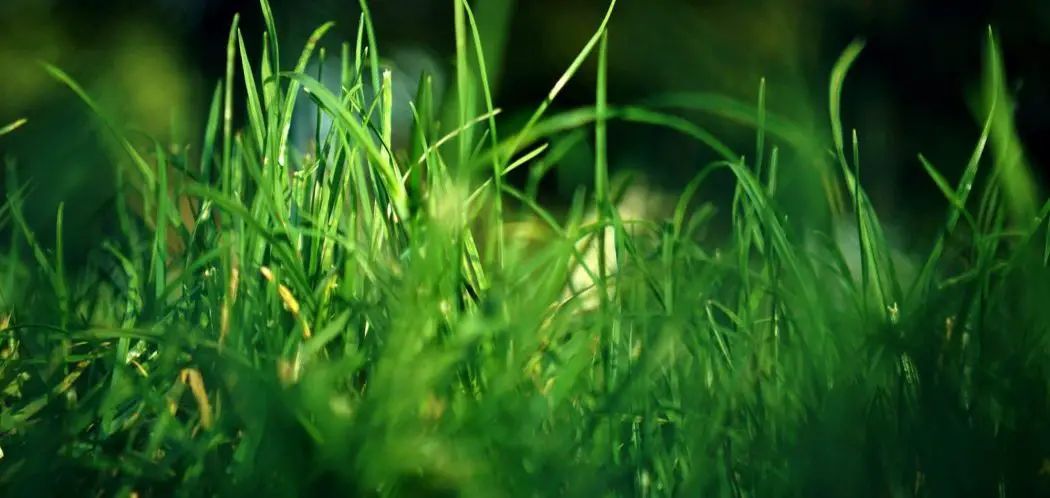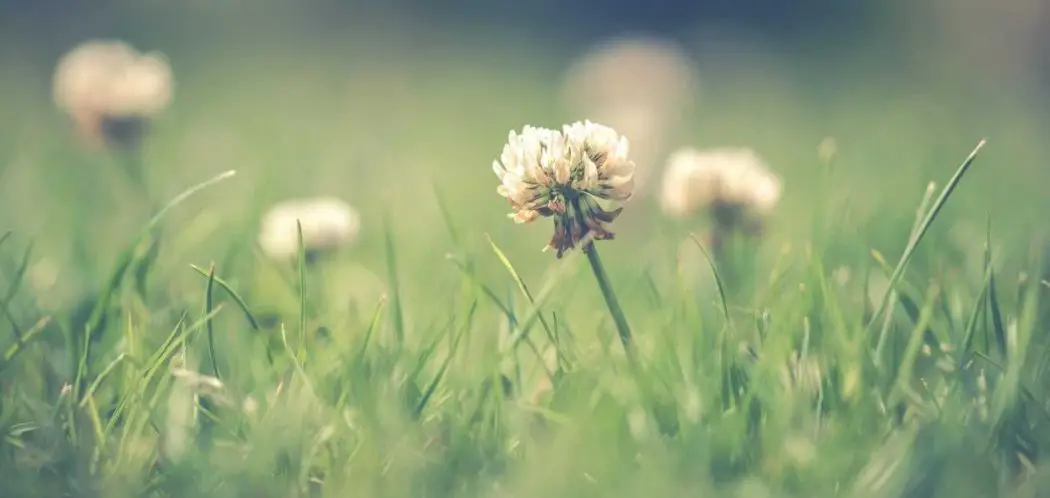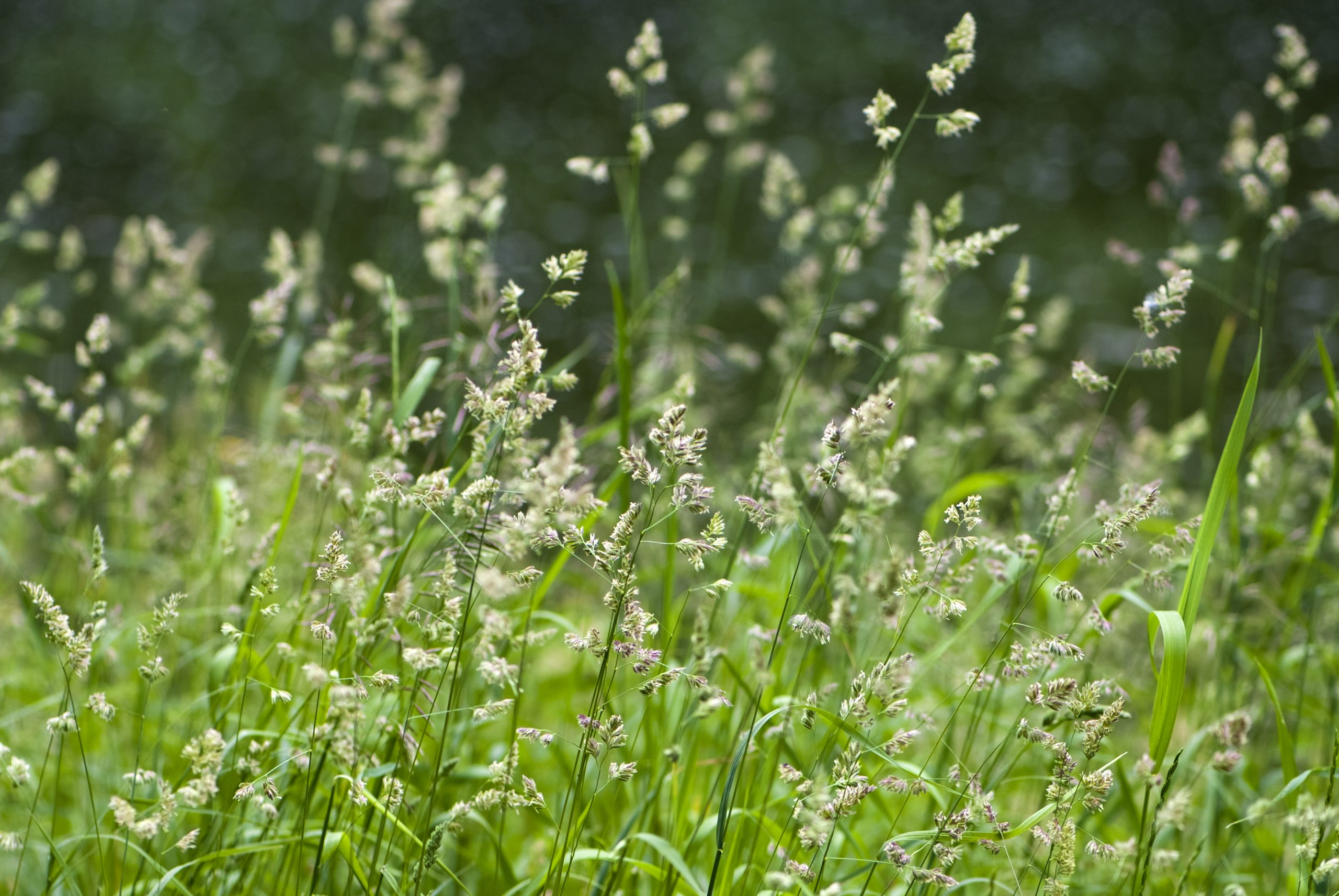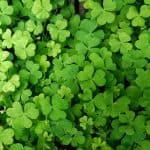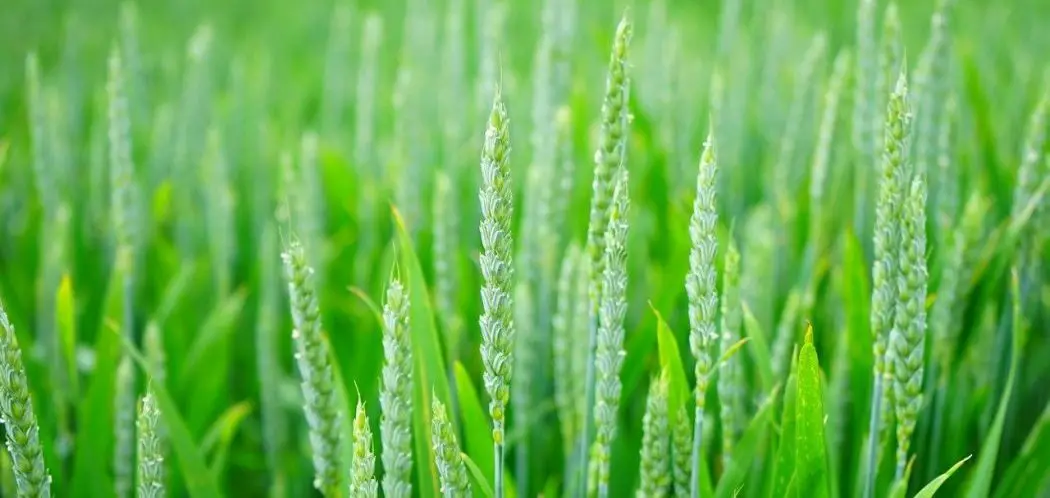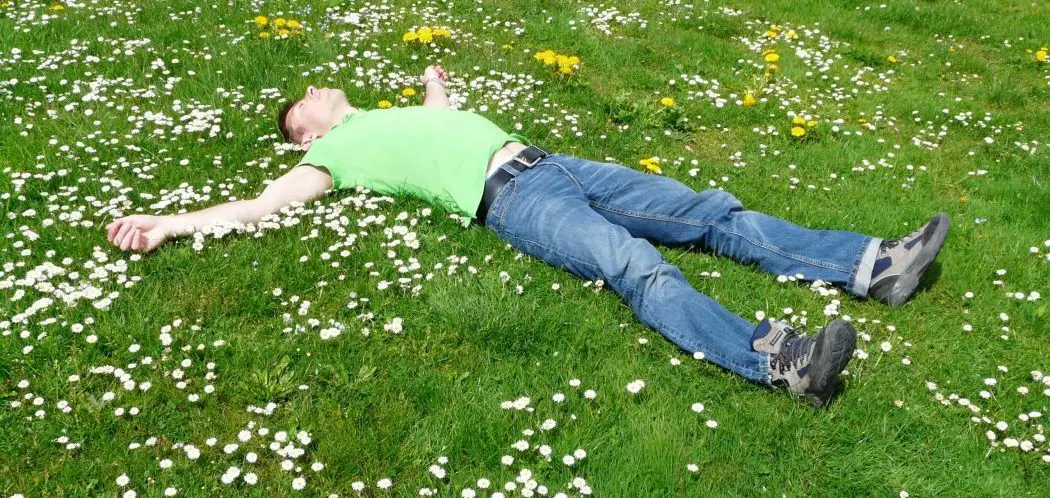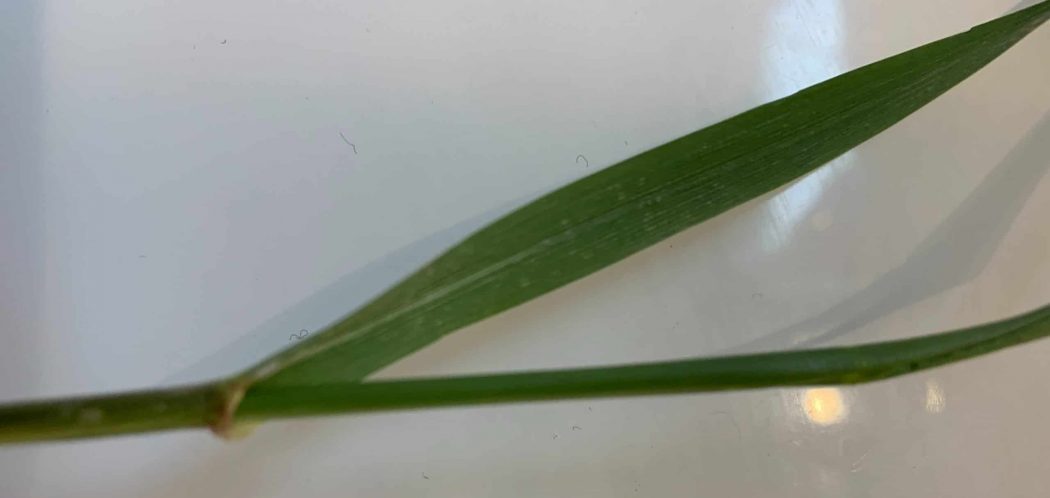The first thing you should do when trying to get rid of the weeds in your lawn is to work out exactly what you are dealing with. Misidentifying weeds in your lawn can lead to incorrect treatment methods which can cost you both wasted time and money. Identifying weeds can sometimes be a little difficult, especially those that already look like the grass in your lawn.
Here are some weeds that look like grass.
Annual Bluegrass
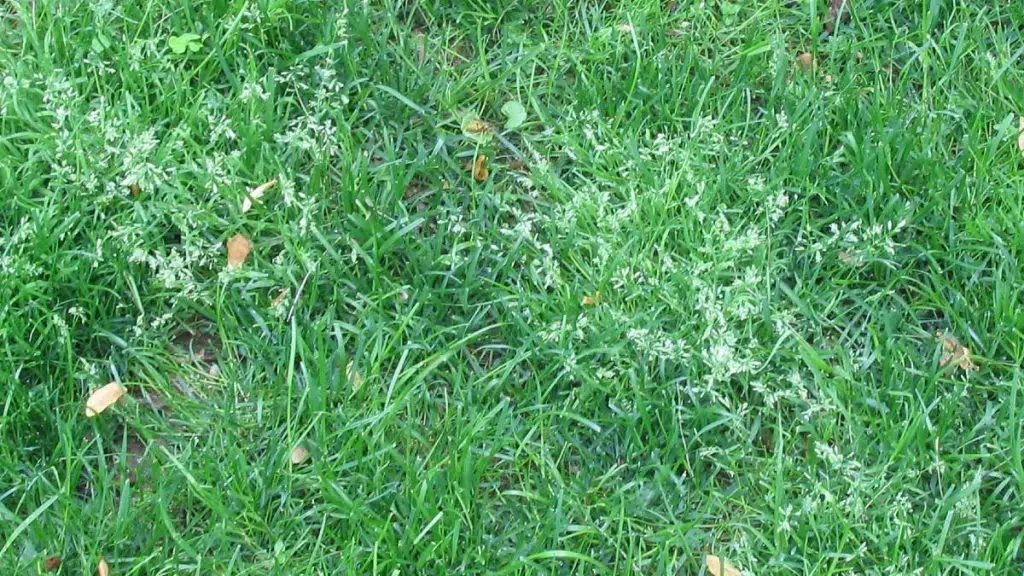
Whether you call it annual bluegrass, wintergrass or Poa annua, this is a difficult weed to control. It’s pretty hard to totally eliminate, a better approach is to try and manage it down to a tolerable level.
Annual bluegrass is a cool season annual grass that begins its life cycle in the fall. The life cycle ends in the springtime.
It has a light green color that looks a lot like your grass. The leaves are smooth on both sides and the flowers have a green/white color.
Annual bluegrass does well in compacted soil that is wet and high in nitrogen. A good prevention method is to avoid over irrigating your soil. You also want to avoid mowing too low so that the weed seeds don’t get enough light to germinate.
You can use a pre-emergent herbicide in the fall. Be careful not to use this this if you plan on overseeing your lawn. Some pre-emergent herbicides will not distinguish between turf grass seed and the seeds of weeds.
You can use Dithiopyr as a post-emergent control. You can get it here (link to Amazon).
Crabgrass
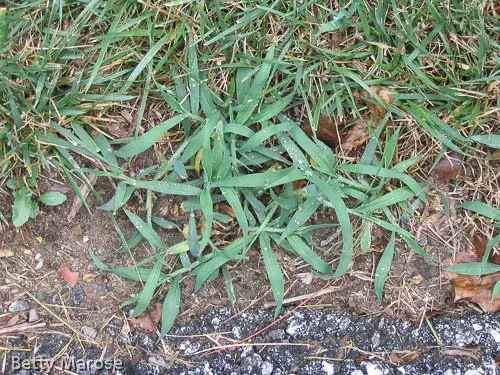
Crabgrass is a very common grassy weed in the US and it’s one that many have difficulty in getting rid of.
It grows in clusters and has a unique look to it. With crabgrass, the stems grow outwards giving it that crab-like look.
It does particularly well in areas of sunlight and struggles to grow in shaded areas.
It also grows well in areas where it has to compete less for water, space and nutrients.
You’ll commonly see it grow in areas near to sidewalks where the ground gets warm.
It has a light green color which tends to darken over time. You may even be able to see a purple color towards the base of the stem.
It can ruin the look of your lawn and choke out your turf grass by providing competition for space and nutrients in your lawn.
It’s easy to mistake crabgrass for other types of grass so take care to identify crabgrass properly to be sure you’re giving the right treatment.
Mowing is not always the best remedy for crabgrass. This can release seeds back into your lawn which might even make the problem worse.
Crabgrass isn’t perennial so it isn’t too hard to take care of. Catching it early and using pre-emergent are you best options for this weed.
It’s best to apply any crabgrass control before soil temperatures reach about 55F at a four-inch depth.
Quinclorac 75 DF (link to Amazon) is a selective herbicide that works well on crabgrass.
Dallisgrass
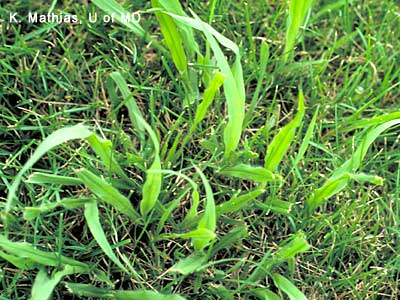
Dallisgrass is a hard weed to control. It’s an invasive grassy weed that looks quite similar to crabgrass. It tends to grow in clumps.
You tend to see it in many different types of lawns including St Augustine, Centipede and Bermuda grass.
The blades of these weeds grow outward from the crown.
It’s so invasive in your yard because it has such a deep root system.
Pre-emergent products don’t tend to be too effective with Dallisgrass because of its extensive root system although they will help prevent the weed from spreading further.
Killing it with roundup is the easiest and most popular method. If you only have a few spots with Dallisgrass, it might make sense to just dig it up.
Dallisgrass if often confused with crabgrass. The best way to tell the difference between the two is by looking at the root system. Dallisgrass has little ribs in the roots.
Goosegrass

Like crabgrass, goosegrass is a grassy annual weed which germinates late in spring and in the summer. Goosegrass tends to germinate a couple of weeks or so after crabgrass when the soil temperature is a little higher.
You’ll often see this weed in gravel along pathways where the ground gets compacted down from foot or vehicle traffic.
It’s typical to see goosegrass on golf courses too, especially on putting greens and other low-cut turf surfaces. It’s really hard to take care of goosegrass, even when mowing really low.
Goosegrass does really well in compacted soil so it’s good to aerate your lawn properly.
When goosegrass goes to seed, bagging your clippings might not be a bad move.
Applying two applications of pre-emergent can help to keep goosegrass form germinating. You’ll want to fertilize and spray for goosegrass a few times during the summer months too. Controlling it early on is going to be a lot easier than trying to get it under control in later summer.
Nimblewill

Nimblewill is a warm season grass. It stays green in the warm weather and turns brown during dormancy in the cooler seasons.
Nimblewill tends to spread very fast.
You will often see some circular brown patches in the fall and through late spring where the nimblelwill is present. This can ruin that nice consistent look you want to get across your grass.
Nimblewill stems are very thin and it does not produce creeping stolons.
The best treatment for nimblewill is a few chemical treatments in summer.
I’d recommend using tenacity on nimblewill. You can get it here (link to Amazon).
If your nimbelwill problem is really bad, you might want to dig it up and soil and then reseed.
Quackgrass

Quackgrass is a very weedy grass that gets into a lot of lawns.
Quackgrass isn’t too difficult to identify on close inspection. It tends to be a lot taller than the grass surrounding it since it grows really fast.
You’ll also want to look for the auricles that wrap around the stem.
Quackgrass is a perennial weed that acts similarly to Torpedograss in the south. It has a deep root system with rhizomes. The roots can be up to 70% of the biomass of the plant. They can grow really fast too, up to one inch per day.
You can get rid of quackgrass by using roundup although it does require quite a large amount for it to work. It needs to get right down into the plant to be totally effective.
If you don’t want to use roundup in your yard, you could try mowing it out first. Try mowing every day if you can for a couple of weeks. This will probably weaken the weed enough. Try mowing a little lower than usual too.
Yellow Nutsedge
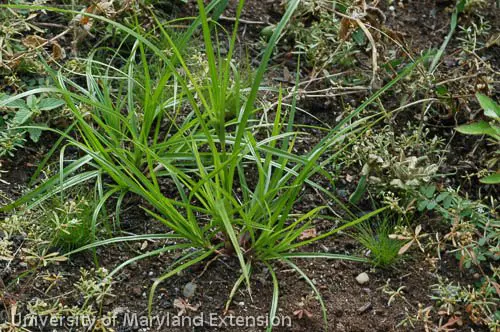
Yellow nutsedge is pretty common thing to get in lawns throughout the US.
It’s a weed that has a very light lime green color. It looks like very similar to grass although it does grow quite a bit faster. The stem has three edges and the nutsedge has long thin blades that are very coarse.
The blades can get pretty tall if you let them grow.
Normally you won’t get an invasion of nutsedge throughout all of your lawn.
It tends to show up in areas where the soil is wet. If you have areas of your yard that don’t drain well, don’t be surprised to see nutsedge show up there.
I like to manually get rid of nutsedge in most cases. Because it’s rooted in wet soil, it’s quite easy to just pull out.
Of course, if you want to keep nutsedge away in future, it’s good to let your soil dry out when possible.
You can also spray nutsedge killer down directly onto it using a hose attachment. I’ve found this to be quite effective too.
Ortho nutsedge killer is a ready-to-spray product that works well. You could also use sedgehammer or prosedge too (links to Amazon).
Wild Onion and Garlic
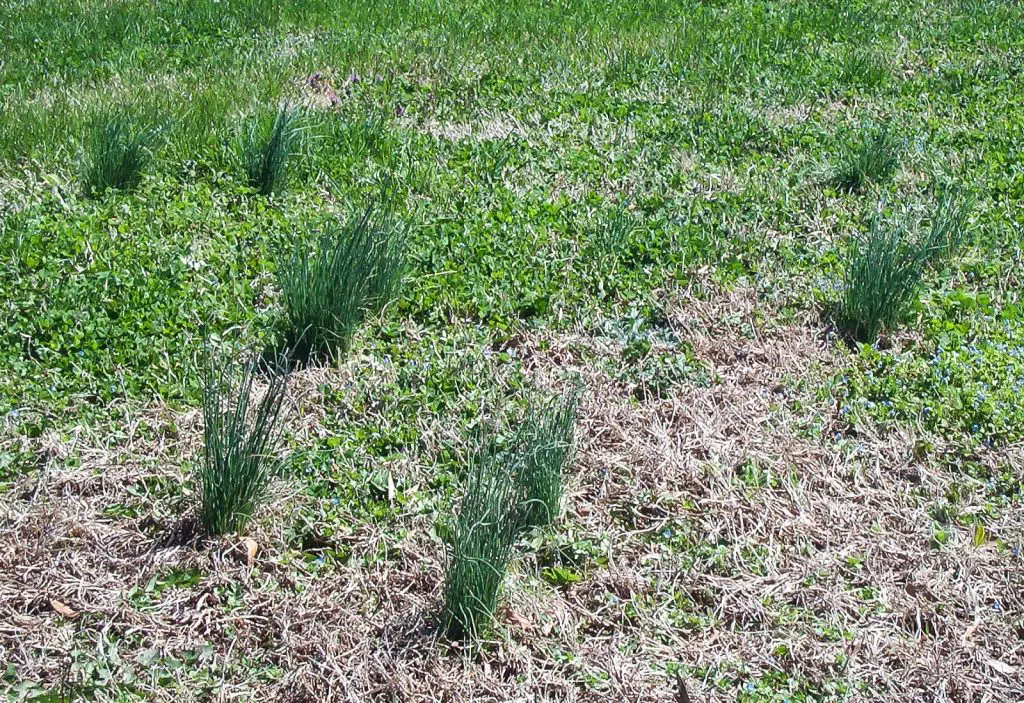
Wild onion and wild garlic usually show up a lot in the fall and in spring time. They pop up out of your grass and kind of blend in to your lawn.
A lot of people confuse wild onion with wild garlic because they look very similar to each other.
You can quickly tell the difference between wild onion and garlic by breaking off the leaf. The leaf on wild garlic is hollow and the leaf on wild onions is solid. You can also look at the bulb to tell the difference between these too.
Wild onion has a more flattened leaf than will garlic.
They both have a pretty pungent smell to them too.
They are difficult to get rid of but not impossible.
If you just have a few clumps, it’s best just to pull them up and be done with it. If you have a yard full of this, you’ll want to spray down some herbicide. I recommend using a product called Blindside. You might also want to add some metsulfuron into the mix too.
Avoid spraying during the transition period of your grass.
Green Foxtail
There are three different species of foxtail that are quite common to find: Yellow foxtail, giant foxtail and green foxtail.
Green foxtail is an annual summer weed that you can dig up just like any other grass plant. It’s usually one of the first grasses that get going in the spring. It can grow in the summer but it’s more a cool season grass.
Green foxtail tends to be a big problem in lawns because they product a lot of seeds and so it can multiply really fast.
Green foxtail likes to grow in clumps. It can get up to a few feet tall in height.
When you peel back the leaf blade you should see a hairy ligule.
To prevent green foxtail in your lawn, you’ll want to get good pre-emergent weed control.
Tall Fescue
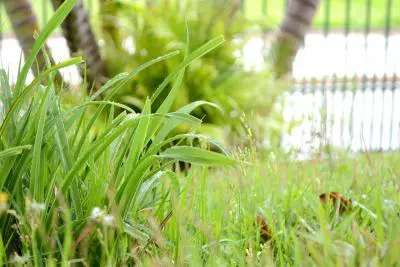
Tall fescue is a cool season grass just like bluegrass or ryegrass. It does tend to have a slightly different appearance to these grasses though; Tall fescue has much wider grass blades.
A lot of people get tall fescue mixed up with crabgrass. If it’s early in the year, chances are you don’t have crabgrass.
Tall fescue likes to grow in clumps so when all of the different grasses in your yard mix together, you won’t have that nice smooth and consistent look.
Tall fescue seems to do well in drought compared to other grass types.
It is a perennial so it will come back every year.
In terms of getting rid of tall fescue, your options would be to dig up the clumps or use a chemical product to kill it off.
The problem is that there is no weed control that you can use to kill tall fescue that will not also kill your turfgrass at the same time.
I like to use a glyphosate which is the main active ingredient found in roundup. This is a non-selective herbicide meaning it will kill the grass and the weeds you spray it with so be careful when applying.
In order for roundup to work effectively, the plant needs to be growing.
After spraying roundup, I would wait a couple of weeks and then dig it up before laying new a new piece of sod.
Weeds That Look Like Grass – Keeping Them Out!
Weeds in your lawn can be a nightmare! Sometimes they look quite similar to your turf grass making them difficult to identify too.
Its critical you identify your weeds correctly since control methods can vary quite a lot.
The best way to prevent weeds in your lawn is to mow your grass regularly. If you’re able to keep your lawn thick and healthy, your grass won’t give weeds the space or nutrients that they need to grow and thrive. Choosing a type of grass like zoysia that competes well with weeds is a good idea too.
Even if you do everything right, you sometimes can get the odd invader.
The key to preventing weeds is stop the next generation. Killing them before they seed is the best form of defense.
Using a pre-emergent product works really well for this. A pre-emergent stops new seeds from sprouting and it won’t hurt any of your established grass. Pre-emergent doesn’t kill anything, it just prevents any future germination and growth.
In some cases, you might want to throw down some roundup to take care of a weed problem but if you don’t like using chemicals in your yard, you might want to just try pulling them out. I’ve found that using hot water is sometimes effective too.
When applying any weed control product, make sure you always read the label properly. Different environmental conditions such as temperature and rainfall can affect how the performance of a herbicide product significantly.
Here are some of my favorite lawn care products
Thanks a lot for making it to the end of this post! I hope you found it useful. Here are some lawn care products that I use and that I think you’ll also find helpful. These are affiliate links, so if you do decide to use any of them, I’ll earn a commission.
In all honesty, these are some of the basic products that I use and recommend to everyone.
Broadcast Spreader
This Scotts Elite dual rotary spreader is not a professional grade model but it’s excellent for homeowners.
I really like the edge guard on it. It’s really easy to switch on and off so it’s great for going around my driveway and flower beds.
If you’re not looking to spend hundreds of dollars, I’d definitely recommend this model. It spreads out a wide path and is great quality for the cost.
Backpack Sprayer
This 4-Gallon sprayer is my absolute favorite. It sprays for a really long time. I’ve had this sprayer for quite a while and I’ve never had the battery run out.
The adjustable pressure switch is a really import feature to me.
You can order a lot of accessories for this model but I’ve never really found much of a need for it.
Head Aerator
Hand aerators are great for small spots if you’ve got construction debris or a spot that constantly dries out.
You can also fill these holes with organic matter that will hold a bit more moisture.
This one by Yard Butler is an absolute bargain. It pulls nice long cores. I also use it for taking soil samples around the yard!

